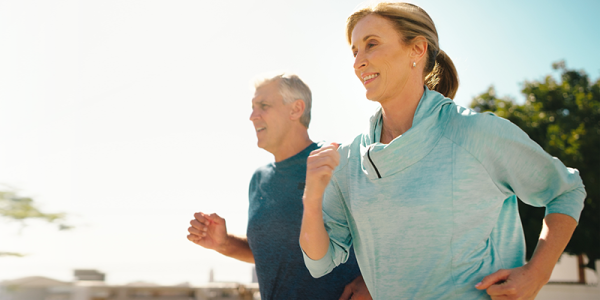
Ever wonder how archeologists or medical examiners can determine the sex of a long-buried skeleton? Nowadays, this can be revealed through a DNA test, but even before DNA testing, a solid knowledge of anatomy could usually separate the Jane Does from the Johns.
While our skeletal differences don’t affect our success at school or work, they can make us more – or less – vulnerable to certain types of injuries. Understanding this can help you exercise more carefully and confidently and lower your chances of getting hurt.
Skeletal Differences
- Pelvis. Yes, childbearing hips are “a thing.” A woman’s pelvis is wider and shallower to make room for a baby’s head during childbirth.
- Bone Size and Solidity. Testosterone stimulates bone growth and increases bone density, which is why men usually have larger, heavier bones than women.
- Rib Cage. The female rib cage tends to be narrower and more rounded compared to the male rib cage.
- Bone Smoothness. The typical male skeleton is thicker and rougher in texture than the smoother, more delicate female skeleton. A man’s bones are stronger and have more robust muscle attachment sites.
- Skull. Compared to female skulls, male skulls tend to be larger, with a lower, sloping forehead, more pronounced brow ridges, larger muscle attachment sites, and smaller, more square eye sockets compared to females.
Muscles, Tendons, and Ligaments
- Muscle mass. Men have a higher muscle mass than women, providing them with greater bone and joint stability while protecting their tendons and ligaments. As any woman who’s ever tried to do a pull up knows, men have superior upper body strength. One study found that the average woman has about 52% of the upper body strength and 66% of the lower body strength compared to the average man.
- Ligament laxity. Estrogen increases collagen in connective tissues and loosen tendons and ligaments. This makes women naturally more flexible than men and gives them an advantage as gymnasts and dancers. Ligaments relax even more during pregnancy, to prepare the body for giving birth. While loose ligaments help with birthing babies, they don’t hold the joints as securely and make women more prone to ligament injuries.
Osteoporosis
Bone loss is a natural part of aging. You keep making bone throughout your life, but not at the same rate as you did in your youth. Osteoporosis, a decrease in bone mass and density, begins when your body starts to lose bone mass faster than it makes new bone. Over time, bones become brittle and weak and susceptible to fracture. Women are more susceptible to osteoporosis than men due to hormonal changes after menopause. Worldwide, one in three women over the age of 50 will experience an osteoporosis related fracture as opposed to one in five men.
Sports and Orthopedic Differences
The anatomical differences described above mean the sexes have different orthopedic vulnerabilities. Some of the athletic injuries that are more common in men are likely due to their higher participation in contact sports, raising the risk of acute traumatic injuries like concussions, hip and groin injuries, and fractures. Males are more prone to shoulder dislocations, Achilles tendon ruptures, and quadriceps tears. Women are more susceptible to overuse injuries like stress fractures or repeat ankle sprains and have a higher incidence of osteoarthritis, tendonitis, and carpal tunnel syndrome. The larger female pelvis affects leg alignment, increasing the likelihood of knock knees and injuries caused by misalignment issues. ACL injuries are eight times more common in women, especially when they play sports that involve jumping, pivoting and landing, such as basketball. Women tend to land in an upright posture, with straighter knees and less core engagement whereas men usually land with bent knees and use their core more.
Safer Workouts for All of Us
While men and women may have different injury risks, we can all use the same common sense guidelines to exercise safely.
- Talk to your doctor before starting an exercise program.
- Always start by warming up and stretching to prevent muscle strain.
- Don’t ignore leg alignment issues. You may be able to balance them out with orthotics.
- Add resistance exercises to your routine to work out both large and small muscles – resistance bands are great for this.
- Focus on healthy eating to keep your weight down and your energy up. Make sure you get plenty of calcium and vitamin D for strong bones and teeth.
- Train consistently. Keep up with strength and flexibility exercises and work on balance and coordination.
- Work your core and lower body. A strong core can help protect your back and strengthen your balance.
For more information about orthopedic conditions and services offered at El Camino Health, visit Conditions and Treatments page.
This article first appeared in the April 2025 edition of the HealthPerks newsletter.

